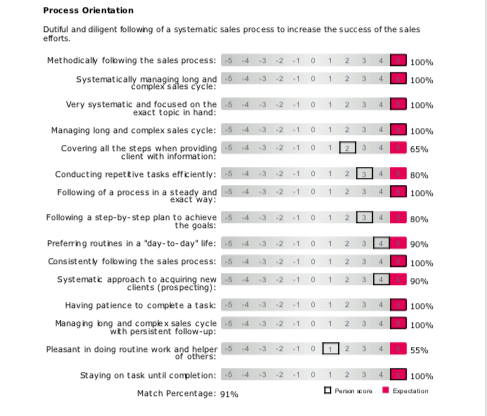The latest Extended DISC® Assessment, FinxS® Sales 18, is a standalone tool designed to improve selling success.

This FinxS® Sales 18 is a DISC-based assessment that uses the same 24 question survey to generate the report. It is designed to help salespeople better understand and further develop their skills in 18 critical competences for selling success. One of the best features of this new DISC assessment is that it can be understood without prior DISC knowledge.
Our clients have typically used the Extended DISC® Sales Professional Assessment, but now they have an additonal option that does not require the individual to be introduced or learn the DISC framework. The Sales 18 report identifies the salesperson's natural, hard-wired style within the DISC framework. It uses the Extended DISC® Profiles and uses the 4 Step Process. The 4 Step process covers how salespeople and prospects are different, how they tend to sell, how to identify styles of prospects, and how to modify our sales style to be more successful.
What are the 18 Sales Competences?
 The assessment identifies your natural, hard-wired DISC behavioral tendencies in 18 clearly defined competences of selling success. Each of the 18 competences is deconstructed into individual behavioral competences to allow for a very clear identification of your unique sales strengths and development areas.
The assessment identifies your natural, hard-wired DISC behavioral tendencies in 18 clearly defined competences of selling success. Each of the 18 competences is deconstructed into individual behavioral competences to allow for a very clear identification of your unique sales strengths and development areas.
The salesperson does not need to focus on all 18 competences; they are not equally important to everyone. For example, you might look more closely at the Prospecting competence if the salesperson is just starting their sales career and needs to build a client base. However, the importance of prospecting tends to decrease as the salesperson relies more on their established client base and referrals.
Interpreting the Sales 18 Assessment

There is one page for each of the 18 sales competences. In the example page above, Process Orientation is defined as, "Dutiful and diligent following of a systematic sales process to increase the success of the sales effort".
The sales competence is further broken down into behavioral dimensions. Each behavioral dimension shows an expectation score of “5” (highlighted in dark pink). However, no one will ever score “5” on every competence. Rather, the expectation scores are the ideal or target scores that are compared against the person's natural behavioral style (the clear box with black border). This sample salesperson has a 91% match percentage for Process Orientation, which means the person identifies process orientation as being naturally comfortable. They should use it as it is a strength, but they should also be careful not to overuse it because they are so comfortable with it.
A sales competence strength is defined as having a match percentage score higher than 66%. Low percentage match scores, below 33%, means the sales competence will take energy and adjustment from the salesperson.
How to debrief the Sales 18
Clients will generally agree with most of the results. However, they may have some reluctance to accept certain development areas. This is a very normal reaction. It is always more difficult to explore weaknesses or blind spots that impede one's present level of success. Also, keep in mind the purpose of this assessment is to provide guidance on how the person can become even more successful. The scores do not measure any behavioral modifications the person is currently making. It simply identifies the person's natural, unmodified DISC style.
Your clients do not need to know the DISC theory in order to understand their results, yet they still receive easy to understand, intuitive information on how comfortable they are in 18 specific sales areas. Your consultant role is made simpler because you don't have to train them to understand their results, you and your client can immediately move forward and focus on achieving selling success.

